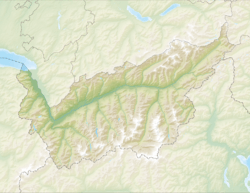Randogne facts for kids
Quick facts for kids
Randogne
|
||
|---|---|---|
|
||
| Country | Switzerland | |
| Canton | Valais | |
| District | Sierre | |
| Area | ||
| • Total | 16.9 km2 (6.5 sq mi) | |
| Elevation | 1,220 m (4,000 ft) | |
| Highest elevation
(Mont Bonvin)
|
2,995 m (9,826 ft) | |
| Lowest elevation | 540 m (1,770 ft) | |
| Population
(December 2002)
|
||
| • Total | 3,138 | |
| • Density | 185.7/km2 (480.9/sq mi) | |
| Postal code |
3975
|
|
| Surrounded by | Icogne, Lenk im Simmental (BE), Lens, Mollens, Montana, Sierre, Venthône | |
Randogne was once a small town, also called a municipality, located in the Sierre area of the Valais canton in Switzerland. It's pronounced (ʁɑ̃dɔɲ).
On January 1, 2017, Randogne joined with three other nearby towns: Chermignon, Mollens, and Montana. Together, they formed a brand new, larger town called Crans-Montana.
Contents
History of Randogne
Randogne is an old place! The first time anyone wrote about Randogne was way back in the year 1224. Back then, its name was spelled Randonni.
Geography and Landscape
Randogne covered an area of about 16.9 square kilometers (about 6.5 square miles) in 2009. A big part of this land was used for farming, about 26%. Forests covered another large section, about 31% of the area.
About 12% of Randogne's land was built up with buildings and roads. A tiny bit, 0.2%, was rivers or lakes. The remaining 30% was unproductive land, meaning it wasn't used for farming or buildings.
The town was located on the northern side of the Rhone valley. Randogne stretched from the Rhone valley, which is about 540 meters (1,770 feet) above sea level, all the way up to Mont Bonvin, a mountain that is 2,995 meters (9,826 feet) high.
Randogne included several smaller areas. There was the main village of Randogne, which was rebuilt with stone after a big fire in 1898. It also included parts of the villages of Loc, Darnona, and Bluche. Plus, a large part of the popular resort area of Montana-Vermala and Montana-Station was within Randogne.
Randogne's Coat of Arms
The coat of arms for Randogne had a special design. It was split diagonally into two parts. The top part was red and showed a shining golden sun with three golden stars around it. The bottom part was gold and featured a red grape with a green stem. Below the grape, there were green hills.
Population and People
In 2015, Randogne had a population of 4,479 people. Many people living in Randogne were from other countries, about 59% in 2008. This was partly because of an international hospitality school in the village.
Between 2000 and 2010, the number of people living in Randogne grew by about 36%. Most of this growth happened because more people moved to Randogne than left.
In 2000, most people in Randogne spoke French (about 60%). The next most common language was German (about 8%), followed by English (about 7%). A smaller number of people spoke Italian or Romansh.
In 2008, the population was almost evenly split between males (49.6%) and females (50.4%). About 20% of the people living in Randogne in 2000 were born there. Another 15% were born in the same canton (Valais). About 12% were born elsewhere in Switzerland, and nearly half (49%) were born outside of Switzerland.
In 2000, about 20% of the population were children and teenagers (0–19 years old). Adults (20–64 years old) made up the largest group at 67%. Seniors (over 64 years old) made up about 13% of the population.
The population of Randogne has changed a lot over the years. For example, in 1850, there were only 253 people. By 1950, it had grown to 1,616 people. In 2000, the population was 2,963.
Economy and Jobs
In 2010, Randogne had an unemployment rate of 4.7%. This means that about 4.7% of the people who wanted to work couldn't find a job.
In 2008, there were different types of jobs in Randogne:
- Primary sector: This includes jobs related to nature, like farming. About 30 people worked in this area.
- Secondary sector: This includes jobs in manufacturing and construction. About 122 people worked in this sector.
- Tertiary sector: This includes jobs that provide services, like working in shops, hotels, or schools. This was the biggest sector, with about 1,097 people working here.
Many people who lived in Randogne traveled to other towns for work. In 2000, about 810 people left Randogne to work elsewhere, while 461 people came into Randogne for work. Most people (58%) used a private car to get to work, while about 9% used public transportation.
Religion in Randogne
According to a census in 2000, most people in Randogne were Roman Catholic, about 56%. About 9% belonged to the Swiss Reformed Church. There were also people who were members of an Orthodox church (about 7%), and other Christian churches (about 2%).
A small number of people were Islamic (about 1.5%), Jewish (0.2%), Buddhist, or Hindu. About 10% of the population said they didn't belong to any church or religion.
Education and Schools
In Randogne, many people had a good education. In 2000, about 31% of the population had finished high school (upper secondary education). About 15% had gone on to get even more education, like attending a university or a specialized college.
In 2000, 129 students who lived in other towns came to Randogne to go to school. At the same time, 241 students who lived in Randogne went to schools outside the town.
Notable People from Randogne
- Elizabeth von Arnim (1866–1941) was a British novelist born in Australia. She lived in Randogne for many years, from 1910 to 1930.
See also
 In Spanish: Randogne para niños
In Spanish: Randogne para niños





